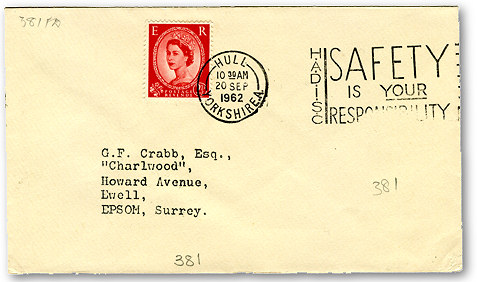 |
|
| News About Us Membership Events Links |
|

Safety Message
This envelope was posted from Hull in 1962. As well as the frank cancelling the stamp, it includes a message - 'Safety is your responsibility'. This and other such messages on envelopes were one technique used in safety education: the attempt to persuade people to change their behaviour and act safely, using 'social' approaches such as the media. Before 1913, when safety education was introduced into the UK, attempts to improve safety were largely reliant upon things such as rules and regulations and warning notices, phrased in stern, official language. However safety education, which started in the workplace and rapidly spread throughout society, used photographs and illustrations to show people what to do - or not to do. Typically it used informal language or novel techniques - anything that would get the message across. Safety messages were to be found on posters, leaflets, booklets, in crossword puzzles, films, competitions, on cigarette cards, items of clothing, drip mats for drinks, stickers, card games, payslips, matchbox labels, milk bottle tops - in short, on a huge variety of ephemeral items. It was produced by all sorts of people: from employers and voluntary organisations (such as the Royal Society for the Prevention of Accidents) to the state in the post-1945 period - think of the Central Office of Information, responsible for campaigns such as the Green Cross Code. The voluntary organisations also included local safety committees - such as the Hull and District Industrial Safety Committee, responsible for having the safety message shown here added to the envelope and abbreviated in the message to 'HADISC'. Why the envelope was retained is unknown, but it has ensured that this means of spreading safety messages has survived. This is just one of the items that I am using in my Arts and Humanities Research Council funded project, 'Living in Safety: the Culture of "Safety" and Accident Prevention in Everyday Life in Britain, c.1900-2000', based at Oxford Brookes University. A further selection of ephemeral items, with commentary, is to be found in my feature 'Safety First! Preventing Accidents in Twentieth-Century Britain' in the August 2011 issue of BBC History Magazine. Mike Esbester
|
This regular feature shows special items from members’ own collections. Submissions by email should include a scan of the item. |
|
Home | News | About Us | Membership | Events | Links | Contact | Item of the month | Articles |
| Copyright © The Ephemera Society 2024. All Rights Reserved. |